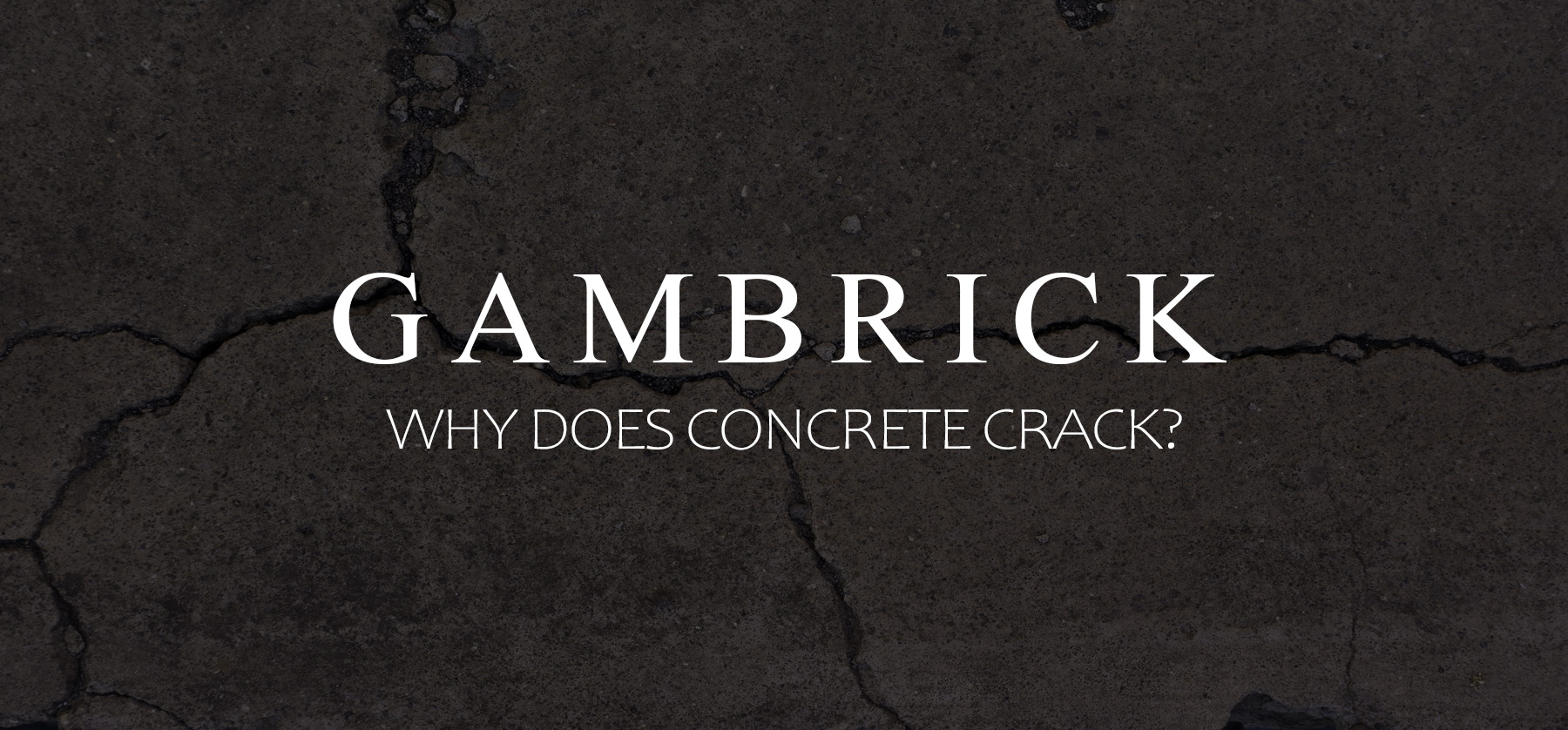
Why Does Concrete Crack?
Concrete cracks for a number of reasons. The most common are temperature fluctuations which cause expansion and contraction, the ingredients and mixture ratio used, the ground on which the concrete is poured, weather, direct sunlight, erosion, and chemical reactions that happen in or on top of the concrete. Some cracks can be simply cosmetic, such as hairline cracks, while others can be structurally damaging.
Concrete is a fantastic building material that’s been used all over the world for centuries to build homes, foundations, patios, roads, sidewalks, bridges dams and even finish work like cast fireplace surrounds and countertops. It’s very strong, durable, weather resistant, easy to make and fairly cheap. It’s also easy to work with and very versatile. But for all it’s strengths, concrete is prone to cracking.
Although concrete is a great building material, it’s susceptible to cracks. This is a fact no matter where you use concrete. But the good news is, if you mix the concrete properly, use the correct mixture for the job, insulate the concrete, and take precautions, you can avoid cracks. You can also add reinforcement inside the concrete like fiber, wire mesh, chemical additives and rebar which strengthen concrete and greatly reduce the chance cracking.
It’s most important to take protective measures in Winter, because concrete cracks most in cold weather. This is due to contraction and the freeze thaw cycle.
By understanding why concrete cracks, you can take steps to prevent it. I’ve been a builder and mason for over 25 years and can tell you firsthand, concrete will crack no matter what you do. You can mitigate it, but some cracks will eventually form. But luckily, they’re generally easy to fix.
In this article, I’ll explain the most common reasons why concrete cracks and what you can do about it.
Why Concrete Cracks
Why does concrete crack? There are quite a few common reasons. Concrete is a very strong, durable material that’s prone to cracks mainly because of how it’s made.
Concrete is made from sand, cement and aggregate stone mixed with water. Often times additional ingredients are added to give the concrete special features like fast setting, crack resistance or more strength. The ratio of these ingredients along with the amount of water added dictate the strength and attributes of the concrete.
Cement is the active ingredient in concrete. Sand, aggregate stone and additives give concrete it’s attributes like strength and durability. When water mixes with cement, a chemical reaction occurs called curing. This process takes place over a period of 28 days. During curing, the concrete dries out, hardens and strengthens. When a Quikrete bag says 3500 psi, or pounds per square inch, that means 3500 psi after curing is complete. At 10 days a 3500 psi concrete is only around 1500 psi. It takes time for concrete to fully cure and reach it’s full potential.
During curing, air bubbles are released from the concrete as it dries, this creates tiny pores throughout the concrete and small tubes. That’s why concrete is able to absorb and hold so much water and why sealing it is so important.
It’s also due to this porous structure that cracks can easily occur. Even though concrete looks super hard on the surface, there are all sorts of areas that can be weaker and prone to cracking inside the concrete where you can’t see.
To avoid some of these cracks reinforcement is used like fiber, wire mesh and rebar. Below are the most common reasons concrete cracks.

Types Of Concrete Cracks
Some concrete cracks are more concerning than others but they’re all considered bad and unnecessary. Here’s an overview of different types of cracks that are common in concrete work.
- Hairline Cracks. Typically these are only surface level. They should be repaired right away because over time they can start to widen or get deeper. As water gets it it can eat at the concrete or freeze. Dirt,mold and mildew can also build up and grow inside even small cracks. Hairline cracks aren’t considered that bad, but they can be over time if not fixed. A good sealant can help.
- Shrinkage Cracks. These occur while the concrete is curing. If too much water was used in the mix it causes shrinking as the concrete dries and cures. To fix this, make sure you use the proper amount of water. Shrinkage cracks aren’t the most serious either but they can be if left alone. Fix them or seal them
- Settlement Cracks. When the ground beneath the concrete settles and a void opens up, it can crack the concrete. These are bad cracks because they compromise the structural integrity of the building .
- Structural Cracks. Anything structural needs repair immediately. A structural crack will only get worse over time and can compromise the building.
Expansion Concrete Cracks
Weather is a major cause of concrete cracks. Both extreme heat and cold can cause a concrete slab or structure to crack. Heat causes concrete to expand. Cold causes it to contract. Since concrete is very stiff, if there are weak spot it can crack during expansion and contraction cycles.
Expansion caused by heat creates pressure and stress on the concrete. If the concrete doesn’t have room to move, it can crack or buckle. This is why relief cuts are included between slabs or concrete structures. They provide the concrete a little room to move without cracking. Without them, the pressure would find a weak spot in the concrete and crack to relieve the pressure.
Think of it in the same way as hot tee pot. Pressure created by steam builds inside the pot until it’s enough to blow open the top which create a whistle. That top is a form of relief valve that only opens when pressure inside the pot is high enough. If there was no relief valve, pressure would continue to build until a weak spot in the pot gave out and broke. This same principle is why hot water heaters can sometimes explode. Built up pressure needs a place to go, in concrete, the relief comes in the form of a gap between concrete slabs or structures.
Heaving Concrete Cracks
When it’s extremely cold, the frozen earth can shift from it’s normal position and then shift back when the ground thaws. This is due to ground water freezing. This process is called the freeze-thaw cycle. It’s very common in areas that get cold enough winters for ground water to freeze.
Keep in mind that this occurs when groundwater freezes, not surface water. The ground stays warmer than the surface since it’s not touched by the air. It has to be really cold to freeze underground water.
While this movement may be very subtle and hardly noticeable to people, even a half inch of movement is a lot to concrete. A concrete structure is typically very stiff without any ability to move. This is why relief cuts are included in concrete slabs like sidewalks and patios. The cuts allow the slab to move a little either up and down or back and forth. Without relief cuts, the movement would cause cracks in the concrete.
Another cause of movement can be plant roots. Trees that grow too close to a concrete slab can easily lift them right out of the ground and cause cracks. This is sometimes called heaving. A slab would have to be extremely strong and thick to resist the pressure caused by a thick tree root.
Concrete Cracks Caused By Weight Overload
Concrete is a very strong material that can hold a lot of weight. But it does have it’s limit. Under extreme amounts of weight concrete can crack.
Every mixture of concrete has a PSI rating, or pounds per square inch. For example, a bag of Quikrete 3500 has 3500 psi. That’s what the number means. It’s a measure of the concrete’s strength. PSI is the amount of pressure the concrete can take before breaking.
The PSI of a concrete mix everything to do with what’s in it. Structural concrete generally starts at around 4000 PSI but can be well over 10,000. Additives like fiber, chemicals or micro rebar can be included in the mix to add even more strength.
Another very common way concrete cracks is when the ground beneath it settles and creates a void. Concrete should be poured on compacted soil. When there a space beneath the concrete that means there’s no support. This is a common problem caused by water if there isn’t proper drainage around the concrete. Concrete can be strengthened even further against issues like this by including a rebar cage inside the concrete. Rebar helps hold the concrete structure together by binding it to the rebar. Think of steel rebar as a sort of skeleton for the concrete.
If you read a set of structural blueprints they’ll tell you how strong the concrete needs to be for a particular project.
Concrete Cracks Caused By Ground Settling
We touched on this a bit in the overload section, but settling is a major concern when working with concrete. A concrete structure should rest on flat, compacted soil with proper drainage. When this isn’t done voids can form beneath the concrete.
Another concern is bad soil. We take a soil boring to see what’s below whenever we build a new house or building. The ground your concrete rests on is very important. If a hold opens up beneath the concrete it won;t be supported properly in that area. This means the load that should have been transferred to the ground below will now put more pressure on the concrete around the edges of the hole. This can create pressure well over the PSI rating of the concrete which results in cracks.
The way you prevent ground settling is by first taking a soil bore to make sure you’re building on good soil. Then take your time creating a solid base. Solid below the concrete should be tamped down and concrete should typically be poured over gravel. You also need proper drainage. Never let water pool and set on your concrete. It can not only erode the soil but also your concrete.
Concrete Cracks Due To Premature Drying
Fine line cracks that appear on the surface of the concrete can happen when the concrete first starts to dry after it’s been poured. These cracks are caused by an uneven drying process.
Sometimes, the concrete’s surface can dry faster than the rest of the concrete. This can be due to heat, wind, or other conditions that cause it lose moisture faster. The surface of the concrete shrinks before the rest which causes tiny cracks.
These cracks and generally surface level only and do not affect the concrete’s structural integrity like other more serious cracks do. But they’re still a problem you should avoid. Small cracks in the concrete surface can become big problems later, especially if you live in a climate that see a freeze/thaw cycle. Water can get into these cracks and then freeze which starts to open the cracks more and more. This can eventually lead to structural issues.
Unfortunately, it’s very hard to repair these cracks because of how small they are. But you can seal them in order to keep water out. Sealant will seep into the tiny cracks and keep water from penetrating into the concrete. It’s a good idea to seal concrete anyway but even more important if you have these micro cracks.
Concrete Cracks Due To Rapid Drying
When dry concrete is mixed with water, a chemical reaction occurs between the cement and water. The concrete immediately starts to dry out and harden. The process is called curing. Concrete continues to dry, harden and strengthen for around 28 days. Even though concrete may feel hard after a day, the process continues inside the structure. Curing needs to take place slowly over a long period of time in order for concrete to reach it’s full strength. If concrete rapidly dries, it can stop the curing process prematurely which weakens the concrete.
Chemicals that get into or are added intentionally into the concrete can cause rapid drying. This can form cracks in the internal structure of concrete.
High strength concrete is very susceptible to rapid drying. Due to the use of silica fume in the concrete mixture, the drying time is sped up. This can make the concrete dry too fast which causes both surface and internal cracks. Whenever you add a chemical to concrete in order to influence it’s strength or dry time, it’s very important to get the ratios just right. Too much will cause rapid drying.
To prevent this cracking, other chemicals can be added to the mixture which slow down the internal chemical reactions that make the concrete dry. You can also spray water on top of the concrete surface to keep it from drying out. Covering it with plastic is another way to keep evaporated water from escaping. Even though concrete needs to dry out, the process has to happen slowly.
Chemical Concrete Cracks
In general chemicals are an issue for concrete. If given enough time, chemicals can eat away at concrete until its integrity is destroyed. While most chemicals that can destroy concrete will never be an issue, others are very common.
One common chemical that most people don’t realize is bad for concrete is salt. I doubt most people even know salt is considered a chemical. If given enough time, salt will eventually cause cracks. In winter, many people salt their driveways, sidewalks, and patios to help melt ice and snow. Spreading salt also provides a safer non slip area to walk.
Salt damages concrete over time by causing corrosion under the surface. This eventually leads to discolored and cracked concrete. The calcium hydroxide present in concrete reacts with the calcium chloride in salt. This creates a new chemical called calcium oxychloride (CAOXY) which is bad for concrete. When forming inside concrete, CAOXY crystals expand, causing internal cracks and weakened concrete. This damage is further amplified by the effects of the freeze thaw cycle.
Salt also lowers the freezing point of water while at the same time raising the pressure of frozen water. This amplifies the effect of the freeze thaw cycle. When ice melts, it carries approximately 10% more water than normal. In low temperatures, this extra water freezes which adds additional ice to the concrete upon refreezing. As ice melts and refreezes it grows, adding more pressure to the concrete.
Good quality concrete is more resistant to salt damage because it’s generally stronger and the pores tend to be smaller. You can also add even more protection by using a good concrete sealer like Saltguard, Saltguard WB, or Saltguard VOC.
Corrosion Concrete Cracks
Most concrete structures are built with an additional layer of reinforcement inside that strengthens the concrete. When building a concrete slab, footing or wall, steel rebar or wire mesh is placed inside the concrete before it’s poured. This metal is typically tied together to form a sort of skeleton for the concrete. Adding an inside layer of metal makes concrete a lot stronger and less prone to cracking. You can also span much greater distances without worrying about cracks.
Reinforcing metal doesn’t typically rust or corrode because it’s encased in concrete. The concrete keeps it safe by keeping out air and water. But if moisture works it’s way to the steel through small cracks and pores, it can start to rust and corrode. Rust is a chemical reaction between metal, water and oxygen. It breaks down the metal which creates and expansive pressure. This pressure pushes at the concrete from the inside which causes cracks and weakened concrete. As the concrete cracks, more air and water can reach new areas of steel. Unless fixed, the problem just gets worse and worse until the entire structure fails.
Concrete Cracks From Shrinking
Shrinking is one of the most common reasons why concrete cracks.
Concrete is made up of cement and aggregate. Mixing typical Portland cement with water creates a paste like substance that’s smooth and easy to work with. The aggregate stone and sand give concrete it’s texture and strength. It’s what makes concrete more of a solid. When concrete is properly mixed, you should be able to hold in your hand and form it like a snowball. This new workability is due to the aggregate. But the binding and hardening is because of the cement.
The correct consistency is very important to make strong concrete. Too much water, or too little, and the concrete will be weak and brittle. This consistency is based on the ratio of water to your dry ingredients. The exact ratio you use depends on the type of concrete ad it’s exact ingredients.
In general, the ratio of water to dry concrete is 3 quarts of water to every 80 pounds of mix. This is easy to figure because premixed concrete bags made by companies like Quikrete and Sakrete come in 80 lb bags.
Using the correct amount of water helps prevent shrinking. Too much water, and your concrete will be more prone to shrinkage.
Concrete Cracks Caused By Water
It’s very important to mix your concrete properly if you want it to be strong. Too much water or too little will result in weaker concrete that’s prone to cracking. Water is a very important part of concrete that people often overlook. A chemical reaction occurs inside concrete between the cement and water. In general, an 80 lb. bag of concrete needs 3 quarts of water for a proper mix.
The ideal consistency of a concrete mix is similar to thick oatmeal. If your concrete mixture has a different texture, add either more water or more dry mix to adjust the consistency.
When your mixing concrete, pour 2/3 of the water in first to mix with the dry. Then pour in the remaining 1/3 after everything is mixed up so you can gauge exactly how much you’ll need.
When your concrete is fully mixed you should be able to hold it in your hand and form it like a snowball. If the concrete is too thin to hold then you need more dry mix. But, if the concrete is too dry and brittle to hold form, it needs a bit more water. The cement should become like a thick paste binding all the aggregate materials together.
As the concrete dries and cures, water inside of the mix evaporates and shrinks. This shrinking can cause cracks.
The amount of cracks caused by shrinking /drying is effected by the consistency of the mix and the amount of water used. The more excess water used in the mix, the more potential cracks can occur. These cracks are not just on the surface of the concrete, but can also extend into the concrete which weakens it’s structural integrity. Concrete slabs can shrink as much as 1/2 inch per 100 feet.
Summary: Why Does Concrete Crack?
Concrete is a fantastic building material that’s been used all over the world for centuries. It’s used to build homes, foundations, patios, roads, sidewalks, bridges dams and even finish work like cast fireplace surrounds and countertops. Concrete is very strong, durable, weather resistant, easy to make and fairly cheap. It’s also easy to work with and very versatile. Simple pour it into any container and it’ll permanently harden into that shape. But for all it’s strengths, why does concrete crack?
Concrete cracks for a number of reasons. The most common are temperature fluctuations which cause expansion and contraction inside the concrete, the ingredients and mixture used, the ground on which it’s poured, weather and sun, erosion, and chemical reactions that happen inside or on top of the concrete. Some cracks can be simply cosmetic while others can be structurally damaging.
Although concrete is a great building material, it is susceptible to cracks. This is a fact no matter where you use concrete. But the good news is, if you mix the concrete properly, use the correct mixture for the job, and take precautions, you can avoid cracks. You can also add reinforcement inside the concrete like fiber, wire mesh, chemical additives and rebar which strengthen concrete and greatly reduce the chance cracking. And if a crack does occur, it’s generally fixable.
If you have any questions or comments e-mail us any time. We’d love to hear from you.

John Mazzuca | About | More Posts |
Custom Home Builder
John Mazzuca is a custom home designer and builder at Gambrick with over 25 years experience in the construction industry. John has designed, built and/or remodeled hundreds of homes, small buildings, and commercial projects. He writes about business, real estate, home building, and household electronics. His work has been featured in Fox Business, Better Homes & Garden, House Beautiful, and more.




















